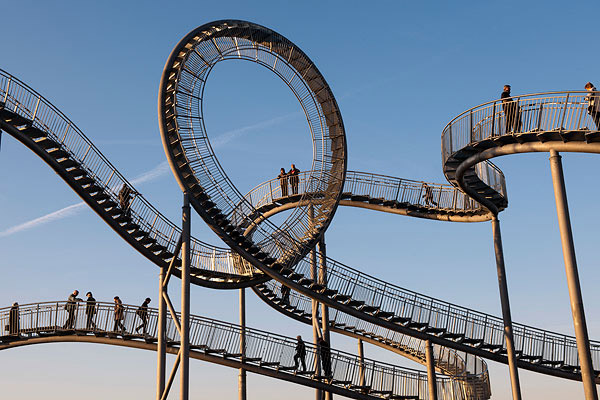 |
| Photograph above: Thomas Mayer, http://thomasmayerarchive.de/ |
Tiger & Turtle – Magic Mountain |
Loop by foot Even from a far distance one recognizes the curvy formation sitting ponderously enthroned on the green hill. The first impression points to a rollercoaster but actually the piece seems to be too exposed and stands there without the signs of a fun fair. No car rattling across the track, no luminous advertising, no screams of the public in a rush of adrenalin. The more one looks into the matter, the more this abstract attraction is irritating. It rests self-contained like autonomous sculpture. And in fact it is an outdoor sculpture that Heike Mutter and Ulrich Genth especially created for the site of the Heinrich-Hildebrand-Höhe in Duisburg where it will be completed in winter 2011. The paradox construction Tiger & Turtle – Magic Mountain is a rollercoaster for pedestrians. An approximately one metre broad steel pathway of 220 metres in length and 15 metres in height guides the public along several curves and slopes – along spectacular vantage points and to spots on which, by foot, one literally cannot turn the corner. But exactly there image and reality meet, absurdity becomes gesture. Appropriate for an art project, Mutter/Genth formally put the walkable sculpture on the green pedestal. From afar one wonders what actually appears more artificial: the elegant turns, that even may remind one of Stella or Moore, or the supporting mountain; a tree-free, evenly overgrown grassy hill, like modelled - one couldn’t imagine a better base for the gigantic, abstract sculpture. Indeed the mountain was there already, but it is all the same artificial – it conceals an accumulation of problematic substances, thousands of tons of toxic zinc-slag have been piled up within just one year, then afforded with a “green coating” and finally complemented with “art in public space”. “There is so much heavy metal in the hill”, said Ulrich Genth, “one used to joke that we could get all the power for our project out of the hill by just pouring acid on it”. Mutter/Genth as artists are slyly enough to meet such situations and deal with the danger of exploitation by environmental politics, with irony and paradox instead of helpless, moral gestures. First, they roof the accumulated residual waste with a rollercoaster, the epitome of the fun and leisure oriented society to then transfer it into a sculpturally slowed down fairground of art. The core idea is to affirmatively top the toxic hill with an attraction that enables, in its literal sense, to overlook everything – this is not without any comicality and works as laconic comment probably more conclusively as with any attempt to critically commentate on this location. One notes a certain ambiguity in the title: Formally talking up the style of the martial name’s tradition of the rollercoaster, their operators like to christen their fairground rides Kolossos or Steel Dragon. Tiger & Turtle refers, so Ulrich Genth, in its content to the “paradox of Achilles and the turtle, so, on one hand, to the turtle as a symbol of slowness and, on the other hand, to the tiger as a symbol of capitalism. The thing only looks fast from far away, but then, it is a struggle to climb it with one’s own feet.” And even more, as a pedestrian, one encounters, next to the fantastic outlook, an actually impassable loop; this confronts the walker with the absurd comicality of the limiting experience of the speed of walking. |
| back to the description of the project--------------------------------------> |